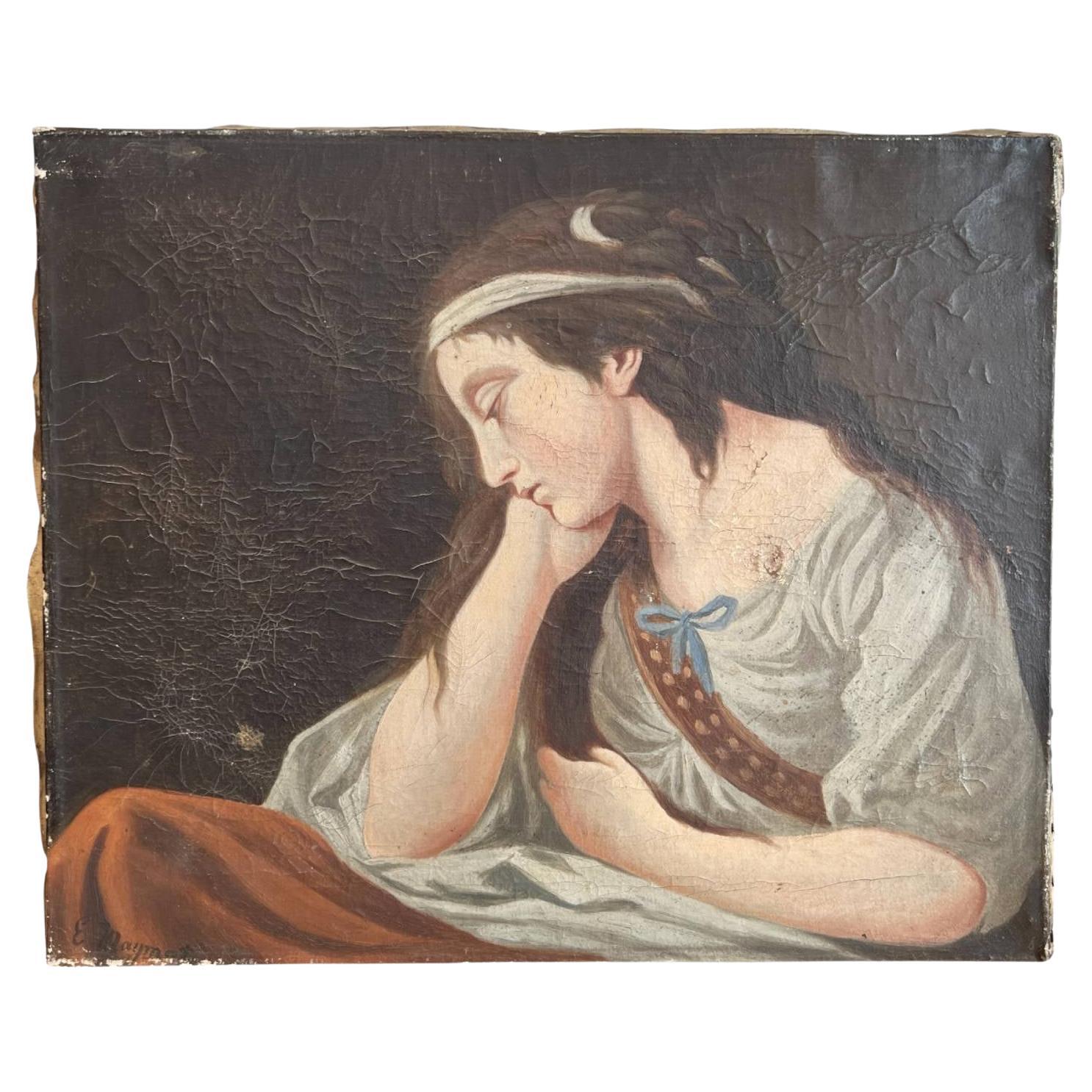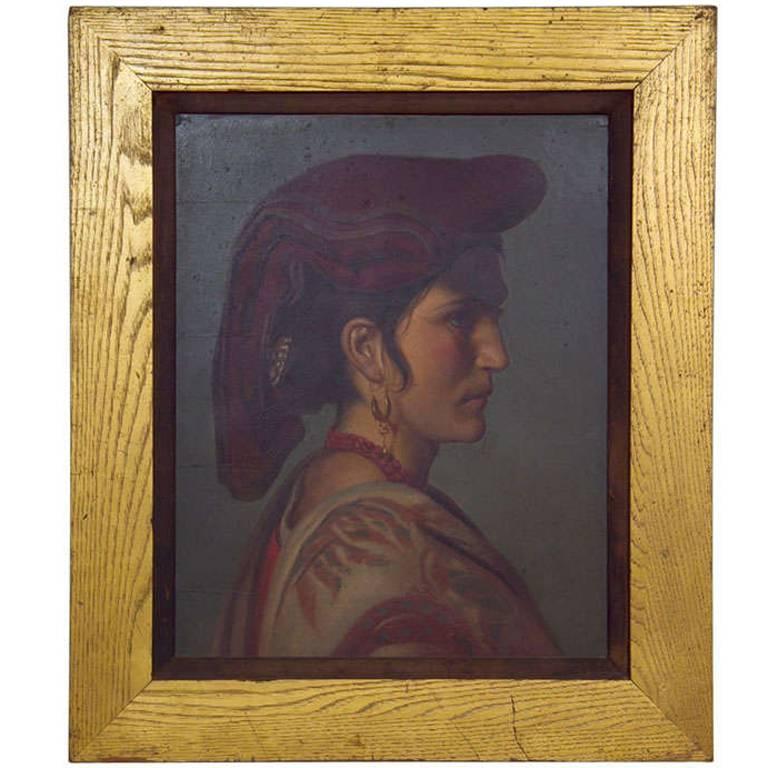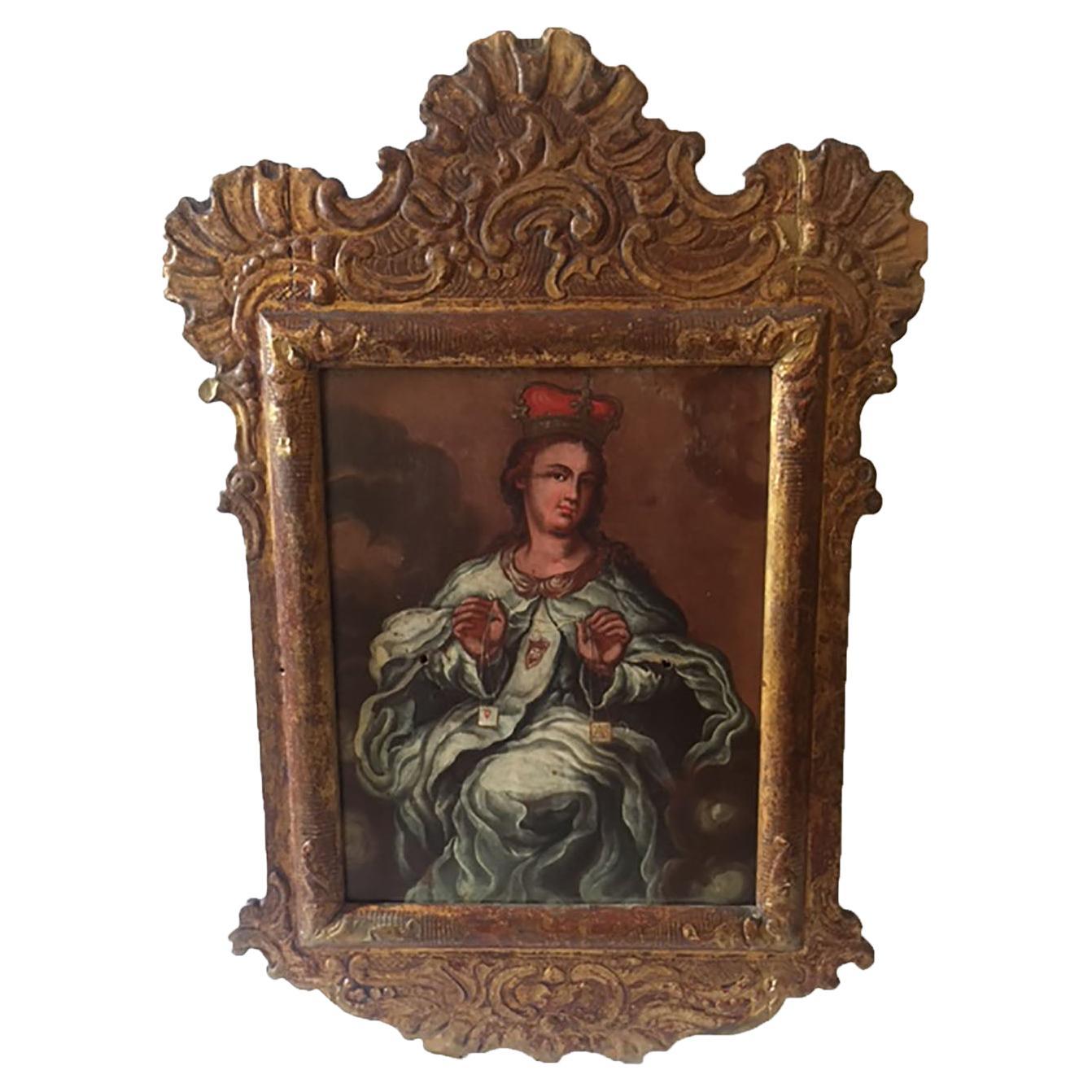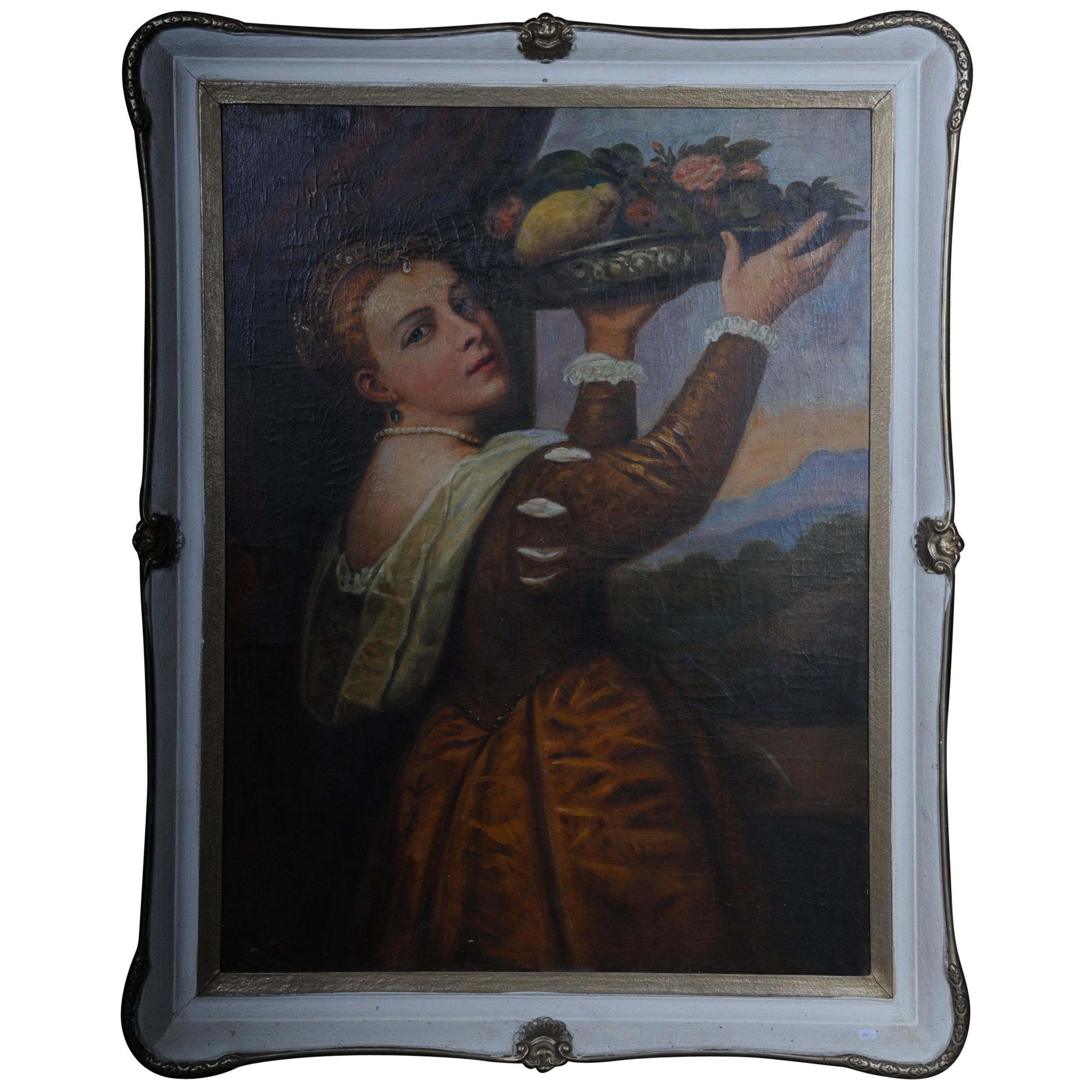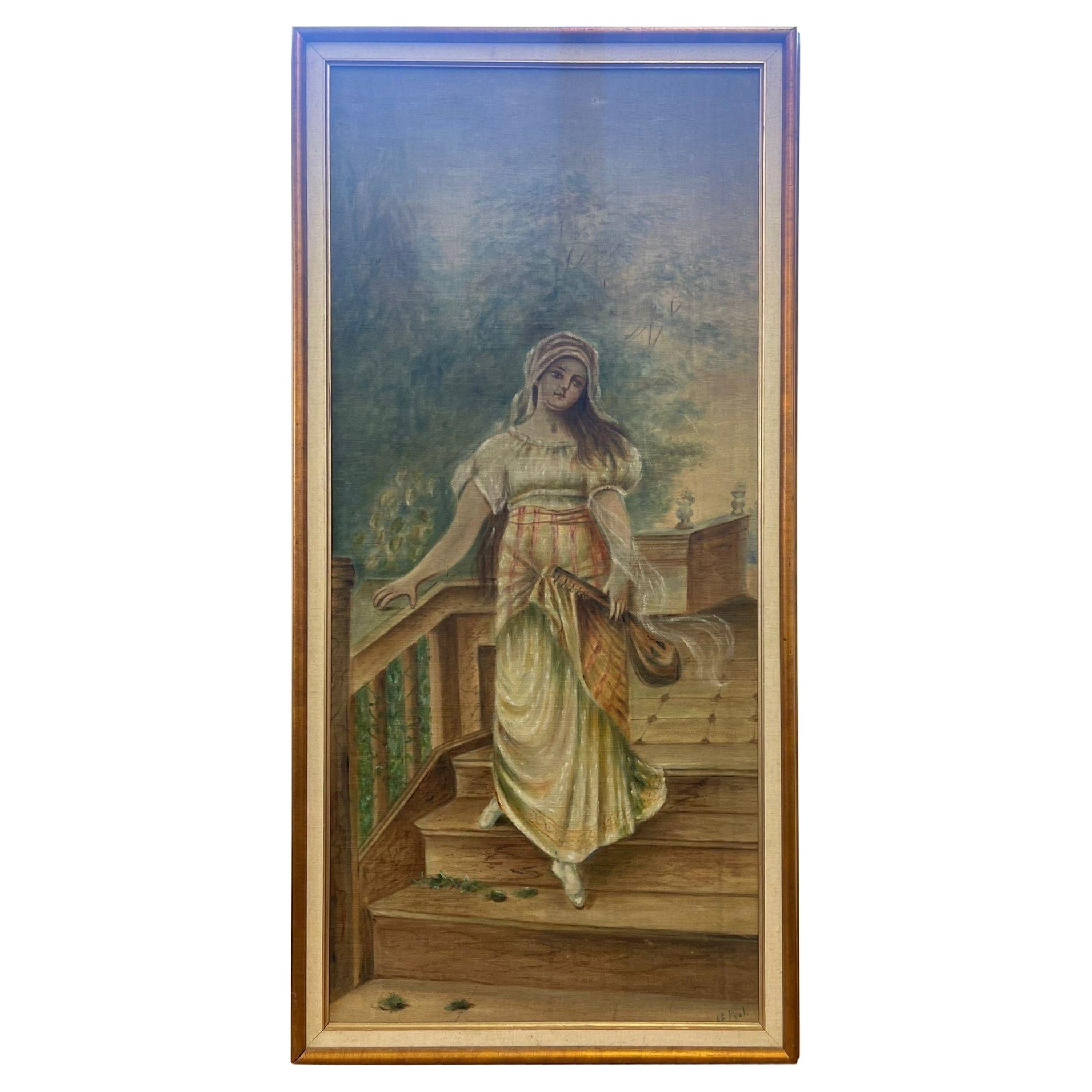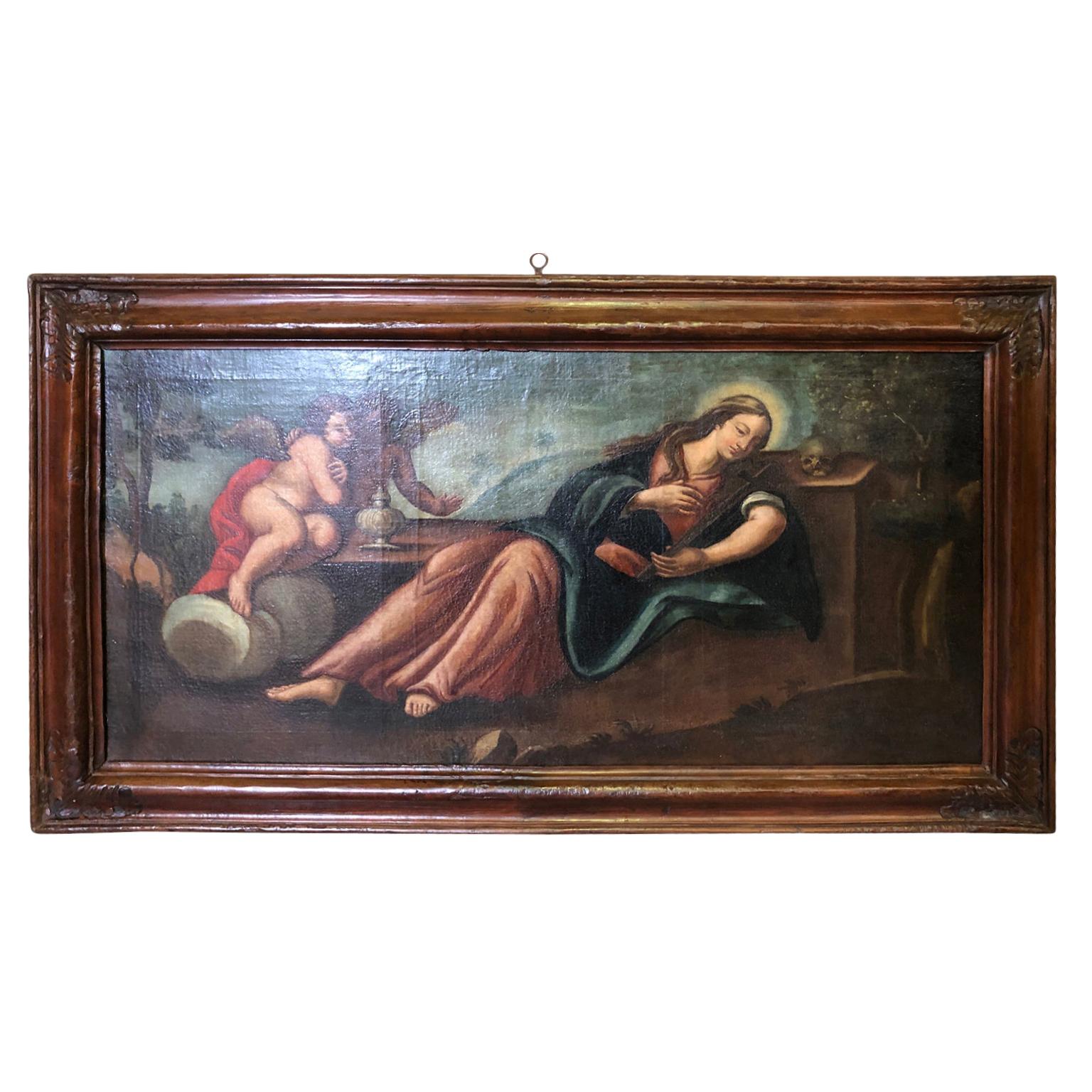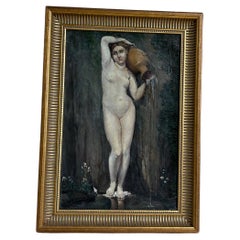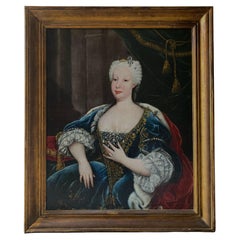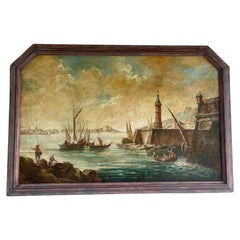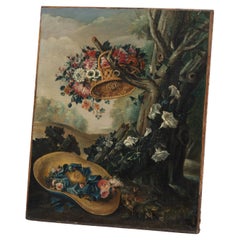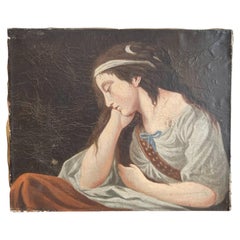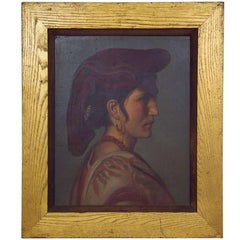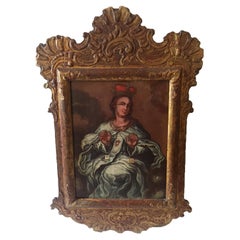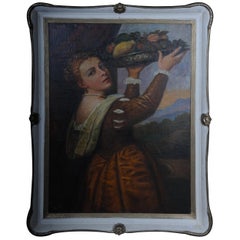Items Similar to XIX Century Portuguese Peasent Woman, Oil on Canvas
Want more images or videos?
Request additional images or videos from the seller
1 of 7
XIX Century Portuguese Peasent Woman, Oil on Canvas
$2,878.03
£2,140.96
€2,400
CA$3,941.01
A$4,381.86
CHF 2,287.97
MX$53,337.94
NOK 29,193.46
SEK 27,352.88
DKK 18,269.87
Shipping
Retrieving quote...The 1stDibs Promise:
Authenticity Guarantee,
Money-Back Guarantee,
24-Hour Cancellation
About the Item
This magnificent painted oil canvas, depicts an anonymously beautiful peasant women on a lush surrounding of forest and bushes.
Portuguese intelectual work of as well an anonymous painter, the female traits of her face are well represented and also on her garments.
She is carrying a basket full of harvested country flowers.
The whole painting conveys a peaceful way of life of the plain old country life, where in deed life was simpler and one can appreciate their surroundings.
This can be yours to decorate an indoor, outdoor accomodation to enhance ones ambient in an atmosphere of true bucolic inspiration.
It ias framed with a good wood work frame, with a gilded freeze complimenting its excellent condition despite its chronological age.
- Dimensions:Height: 45.28 in (115 cm)Width: 25.6 in (65 cm)Depth: 1.97 in (5 cm)
- Materials and Techniques:
- Place of Origin:
- Period:
- Date of Manufacture:c.1800
- Condition:Wear consistent with age and use.
- Seller Location:Lisboa, PT
- Reference Number:1stDibs: LU7365238579982
About the Seller
5.0
Vetted Professional Seller
Every seller passes strict standards for authenticity and reliability
Established in 2018
1stDibs seller since 2022
14 sales on 1stDibs
Typical response time: 5 hours
- ShippingRetrieving quote...Shipping from: Lisboa, Portugal
- Return Policy
Authenticity Guarantee
In the unlikely event there’s an issue with an item’s authenticity, contact us within 1 year for a full refund. DetailsMoney-Back Guarantee
If your item is not as described, is damaged in transit, or does not arrive, contact us within 7 days for a full refund. Details24-Hour Cancellation
You have a 24-hour grace period in which to reconsider your purchase, with no questions asked.Vetted Professional Sellers
Our world-class sellers must adhere to strict standards for service and quality, maintaining the integrity of our listings.Price-Match Guarantee
If you find that a seller listed the same item for a lower price elsewhere, we’ll match it.Trusted Global Delivery
Our best-in-class carrier network provides specialized shipping options worldwide, including custom delivery.More From This Seller
View AllFemme au Jarre Oil on Canvas
Located in Lisboa, PT
Femme au Jarre, Oil on canvas.
20th century.
Category
20th Century French Paintings
Materials
Canvas
Portrait of D. Maria Bárbara De Bragança, Circle of Louis-Michel Van Loo
By H. van Loon
Located in Lisboa, PT
PORTRAIT OF D. MARIA BÁRBARA DE BRAGANÇA (1711-1758), QUEEN OF SPAIN
Circle of Louis-Michel van Loo (1707-1771)
Oil on canvas
Her Royal Highness, the Infanta Maria Barbara of Braganza (1711-1758) was the first-born child of King John V of Portugal (1689-1750) and his queen consort Maria Anna of Austria (1683-1754). Born in December 1711, she had the Convent Palace of Mafra built in her honour following a vow made by her royal father. Her status as Princess of Brazil, inherent to 18th century Portuguese presumptive heirs, would however be superseded once the queen gave birth to two male princes, D. Pedro (1712-1714) and D. José (1714-1777), preventing her from ascending to the throne.
Daughter of one of the most illustrious monarchs of his time, Maria Barbara was carefully educated to become a fond admirer of the arts, and of music in particular, having had the Italian composer Domenico Scarlatti (1685-1757) as her music teacher.
On the 10th January 1723 the young princess was betrothed to the Infante Ferdinand of Spain (1713-1759), eldest son of King Philip V (1683-1746). Six years later, on the 19th January, she entered her new country in a carefully choreographed ceremony that became known to history as the “Exchange of the Princesses”. This unique event took place on a specially built Bridge-Palace, a wooden, luxuriously decorated structure that included various modules and rooms, on both banks of the river Caia, the natural border between the town of Elvas in Portugal and of Badajoz in Spain. Simultaneously, on the same day that the Portuguese Infanta crossed the border to marry the Spanish Crown Prince, her new sister in law, the Infanta Mariana Victoria of Bourbon (1718-1781), her husband’s sister, crossed the same bridge in the opposite direction to marry Prince D. José, the Portuguese heir to the throne.
Once married, Maria Barbara would spend 17 years as Princess of Asturias, only becoming Queen of Spain at her husband’s accession following the death of Philip V in 1746. She is portrayed in the 1743 painting by Louis-Michel van Loo (1707-1771) now in the Prado Museum, in which Philip V had himself represented with all his close family.
The new Queen would take an important role at court eventually becoming the liaison between her husband and the King of Portugal, particularly throughout the negotiations for the Treaty of Madrid (1746-1750). Maintaining her interest in music, she patronized the Italian castrato singer Farinelli (1705-1782) while remaining close to her old master Scarlatti, having herself composed some sonatas for a large orchestra. She would also commission and fund the building of the Royal Salesians Monastery complex in central Madrid, where both her and Ferdinand VI are buried.
The portrait we are presenting for sale shows the Queen in half-length, turning left at three quarters. She is wearing a blue low-cut dress embroidered with flowers and foliage, over a lace cuffed white blouse, and an ermine cloak pined on the left-hand side by a diamond broach. The powdered hair style is held sideways by a seven diamond and black plume headdress and topped by a small gold and pearl crown. The right arm rests on a cushion while the left hand, at chest height, holds a miniature male portrait.
The Infanta’s features are analogous to the 1725 portrait by the painter Domenico Duprà (1689-1770), also in the Prado Museum collection. Further similarities can be found in another portrait by Louis-Michel van Loo, in which a seven diamond and black plume headdress is also present. In this work, the cushion supporting Maria Barbara’s right arm has also some obvious similarities to our painting. The same diamond headdress reappears in Van Loo’s above-mentioned portrait of Philip V’s family dated from 1743.
It is nevertheless in Lisbon’s Ajuda National Palace that it is possible to find an almost identical depiction of the Infanta holding a miniature portrait of her husband. In it, the future Ferdinand VI is portrayed facing right at three quarters and wearing a curly wig, suit of armour, the golden fleece insignia and a blue band, in a composition that closely resembles an 18th century Spanish school painting that appeared in the art market in January 2016.
Another detail common to various portraits of the Portuguese Infanta and Queen of Spain is the small gold and pearl crown on her head. In another Van Loo painting, also from the Prado Museum, in which Maria Barbara is portrayed as Queen, this crown is represented together with a headdress similar to the one previously described. Another two paintings by the same artist, at the Royal Academy of Saint Ferdinand, include the same ornament.
We must also refer the paintings by the artist Jean Ranc (1674-1735). In one, dating from 1729 (Prado Museum), the Infanta is depicted outdoors holding a flower bouquet and wearing a yellow silk dress with red cloak, and a set of diamond and ruby jewellery that includes a headdress similar to the one present in our portrait. Another work by the same artist, belonging to the Complutence University of Madrid, depicts the Infanta sumptuously dressed in identical colours to our painting and wearing an elaborate headdress and diadem.
These portraits, beyond their iconographical importance as contemporary records of the Infanta and Queen Maria Barbara, are also illustrative of 18th century fashion for jewelled head dressing. Often, flowers were combined with joyful adornments, composing almost theatrical displays that would reinforce the ostentatious nature of the image. The ornamental flowers and the chromatic character of the jewels would complement the luxury of the colourful dresses in blue, crimson, green or other silk shades, in compositions whose sole purpose was to highlight a royal sitter’s wealth and power, becoming an essential statement accessory within the strict court protocols and codes of conduct.
Circle of Louis-Michel van Loo (1707-1771)
Slowly but steadily, the resolute, tranquil and dignified attitude of Renaissance and Baroque portraiture becomes artificial and presumptuous. Mid 18th century society favours elusive expression and psychological deepness, albeit limited to the face, that, with emphasis on detail, on the rich colour palette and on changing costumes and landscapes, associated to the courtliness of gestures, creates a strongly artificial environment while maintaining a highly poetic intrinsic character.
Louis-Michel van Loo followed a dynasty of famous Dutch origin artists that had settled in France. Initially taught by his father, Jean-Baptiste von Loo (1684-1745), the younger van Loo studied in Turin and Rome and frequented the Paris Academy. In Rome he worked with his uncle Charles-André van Loo (1705-1765) and become a painter for the Turin Court. In 1737 he arrived in Spain being summoned by Philip V to succeed Jean Ranc as painter of the king’s chamber.
In Madrid, his work covers the numerous Court commissions and the Royal Saint Ferdinand Fine Arts Academy, of which he was a founding member and director for the Painting department in 1752. Is production at court consisted essentially of numerous portrait paintings, often Royal gifts...
Category
Antique 18th Century Spanish Baroque Paintings
Materials
Canvas
French 18th Century Oil on Canvas Representing a Harbor with Boats
Located in Lisboa, PT
An oil painting on canvas representing a harbor with boats, in Marseille, and attributed to the Joseph Vernet School. France 18th century.
Joseph Vernet was a prominent 18th-century...
Category
Antique 18th Century French Paintings
Materials
Canvas
Oil on Canvas Representing Flowers. 19th Century French School
Located in Lisboa, PT
Oil on canvas representing flowers. 19th century French School.
Category
Antique 19th Century French Paintings
Materials
Canvas
Chicken coop, Oil on canvas, late 18th century
Located in Lisboa, PT
Chicken coop, Oil on canvas, late 18th century
Category
Antique Late 18th Century British Paintings
Materials
Canvas
Late XVIII Century Glass Painting of Sheperd on a Bucolic Scene
Located in Lisboa, PT
Shepherds and pastoral scenes have been popular subjects in art for centuries, appearing in various styles and mediums, including paintings, drawings, and sculptures.
Artists often depicted pastoral landscapes with shepherds tending to their flocks, conveying themes of simplicity, harmony with nature, and rural life.
Pastoral art...
Category
Antique Late 18th Century French Paintings
Materials
Glass, Wood
You May Also Like
19th Century Renaissance Antique Painting Woman - Signed
Located in New Orleans, LA
A beautifully executed Renaissance-style painting depicting a woman in period dress, rich in classical detail and serene expression, signed by the artist—evoking the grace and timele...
Category
Antique 19th Century French Paintings
Materials
Canvas, Paint
19th Century Portrait of an Italian Woman
Located in Woodbury, CT
An early 19th century oil portrait on board of an Italian woman in traditional costume. Framed in oak with gold leaf. Board measures 21 in. x 17 in.
Category
Antique 19th Century Italian Paintings
Materials
Canvas
Late 18th Century Lady Saint with Crown Oil Painting on Board, Framed
Located in Dallas, TX
Circa 1780 Virgin of the Scapular, Anon Venezuelan School, a fabulous painting in the original carved wood gilded frame. Something was originally in the small square holes on either ...
Category
Antique 1780s Venezuelan Paintings
Materials
Paint
Oil Painting Lavina the Daughter of Tizians Mon. F. W, circa 1920
Located in Berlin, DE
Oil Painting Lavina the Daughter of Tizians Mon. F. W, circa 1920
hand painting
circa 1920.
White frame
signed F. W.
(S - 203)
Category
20th Century Paintings
Materials
Canvas
Vintage Framed and Signed Original Painted Portrait of a Woman on Fabric.
Located in Seattle, WA
This Artwork depicts a woman with a guitar walking down steps. Possibly oil or acrylic. Professionally framed and matted. Vintage Condition Consistent with Age as Pictured.
Dimensio...
Category
Vintage 1970s Mid-Century Modern Paintings
Materials
Fabric, Acrylic
18th Century Spanish Oil Painting of Mary Magdalene
Located in Round Top, TX
A breathtaking 18th century Spanish oil on canvas painting of Mary Magdalene - Madeleine - in is original frame. Beautiful detail.
Category
Antique Mid-18th Century Spanish Paintings
Materials
Canvas
More Ways To Browse
Tubular Steel Bed
Used Furniture Marin
Used Furniture Pasadena Ca
Vintage Art Deco Headboard
Vintage Barrel Stand
Vintage Glass Rabbit
Vintage Japanese Tile
Vintage Red Chinese Cabinet
Wood Sphinx
17th Century Dutch Drawings
1903 Clock
1960s Walnut Headboards
200 Lex
3 Leg Table Lamp
Antique Bamboo Cane
Antique Chinese Hand Fans
Antique Farmhouse Kitchen Cabinets
Antique Glass Chicken
